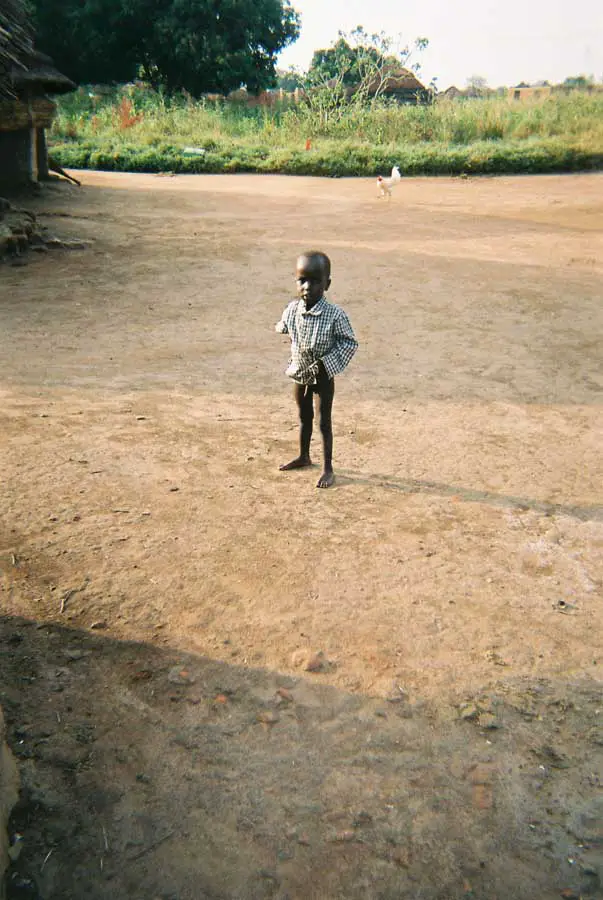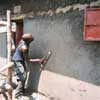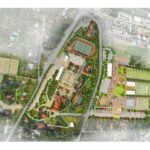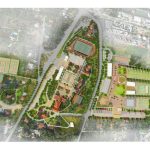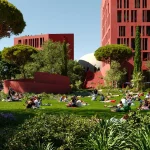Uganda School Building, Vocational Training Centre, Article 25 Africa project design news
Uganda Buildings : Article 25 Africa
Climate Responsive Designed Uganda Buildings Developments
20 Jan 2011 – update information linked at the base of this article
‘Article 25: the built environment’s charity’
![]()
Monthly Report
by architect Henning Stummel for Article 25
Written for www.e-architect.com
Vocational Training Centre for Former Child Soldiers, Patongo, Uganda
One of the least reported or understood conflicts of our age has run out of steam as thousands of former child soldiers of North Uganda’s Lord’s Resistance Army are looking for reintegration into society. Under the leadership of Joseph Kony, a self-professed spiritual medium, thousands of children were abducted to fight. His LRA had the distinction of having the youngest soldier, only five years old, forced to fight with small arms.
Photograph of a boy taken by local child during participatory workshop, which asked them to use disposable cameras to capture aspects of their community which were ‘positive’ and ‘negative’. Needless to say, this was ‘negative’:
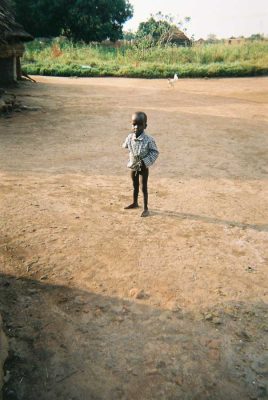
During this twenty year conflict the population of Patongo swelled, as this isolated town turned into a place of refuge, sustained by global food aid and half-heartedly secured by Uganda’s lackluster army. Emergency NGOs operate in disaster areas and as a conflict subsides they pull out and leave a vacuum. In Northern Uganda it has taken quite a while for other organizations to step in.
Article 25, the UK’s leading built environment charity, teamed up with children’s rights charity Jubilee Action to design and build a small vocational training centre. This will give some of these former child soldiers, many of whom are now adults, a second chance – an opportunity to catch up on education and gain practical skills.
To design a civic building in this context is a departure from bunker mentality which has seeped into the very fabric of the town – a step towards a more peaceful, considered and stable society. This project is about creating a place to rekindle skills, nurture talents and rebuild confidence. In so doing this school will help young people to put the past into the past and to overcome. We wanted this building to be a sanctuary and an exemplar – modest but proud, simple and yet refined.
Community participation workshop facilitated by Henning Stummel:
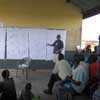
Almost a year ago we travelled out to this remote place and undertook workshops with youths, analyzed the local building methods, surveyed the site and sought out craftsmen and builder’s merchants. This work followed a format set out by Article 25 and serves to gain a better understanding of what is required and what is achievable.
We found that twenty years of conflict cannot simply be brushed under the carpet. Cataclysmic trauma has been caused by abduction, fear, plunder, hunger and rape, and this has resulted in skills and trades being lost, education neglected, property destroyed, and the regression of civilization.
The buildings hastily erected during the years of conflict speak of desperation and fear. Coarsely welded steel bar windows and padlocked solid steel doors offered a last line of protection from a marauding and hungry children’s army struggling for their own survival. Patongo itself is a chaotic hotchpotch of African huts and shop houses built of inferior brick.
Patongo landscape, rapidly deployed temporary housing for IDPs:
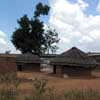
Building materials are still scarce and skills limited. Corrugated metal sheets and cement have to be brought in. The challenge is to respond to the locality, to make do with what is available, to strive for what is achievable and to respond to the harsh climate. The quest is for a new, simple vernacular that gently pushes the boundaries and raises the bar.
The site is a flat field outside of Patongo and the brief easily divides into four elements: reception and catering, classrooms, workshops and finally offices and library. We developed a scheme that revolves around a central courtyard. Four single storey pavilions arranged in pinwheel fashion define a protected communal space overlooked by colonnaded walkways on all sides. This central square is to be landscaped and in the future the pavilions can either be extended individually or further quads can be added to the side and or behind the first quad.
Model of the Article 25/Jubilee Action Vocational Centre:

The single storey pavilions have been designed for cross ventilation and good levels of light. The robust and reflective galvanized metal roofs have generous roof overhangs with guttering for rainwater harvesting. Furthermore they have a vent at the apex, so that on calm days the stack effect will help ventilation.
Walls and footings are to be built with stabilized soil blocks. This method, widely used in developing countries, is new to this region and more sustainable than the inefficient burning of local bricks. Sifted moist soil excavated on site is mixed with about six percent cement and using a special manual press this is squeezed into rectangular blocks. The rubble sifted from the soil can be used as aggregate for the concrete floor slab and the excavation holes can be incorporated for foundations or as latrine pits.
Using basic techniques to test soil quality, and mixing them with cement to create soil stabilized blocks:
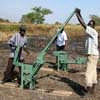

We opted for a flat fronted block, to be laid with mortar. Whilst there are alternative interlocking blocks, which cut down on the amount of cement required, we found that these are not suited for corners and reveals. The appearance of the flat blocks is neat and the walls require no further rendering. The floor slabs in the rooms are to be cast in concrete and these exposed materials offer a thermally stable and pleasant environment.
The entrance building with reception/shop and open catering area, invites visitors to cross the threshold and encourage youngsters into higher education. The security strategy is to provide small rooms that can be completely secured and allow open access to all other parts of the campus.
This ensemble will offer a secure and peaceful place that helps to define and form a community and it will become a place of interaction, inspiration and possibility. Further support for this special project, which is now about to go on site, is very much appreciated.
www.article-25.org/give
www.jubileeaction.co.uk/projects_uganda_amazing_youth_centre
Henning Stummel
Henning Stummel grew up in London and Wiesbaden, Germany, studied architecture and town planning at the TH Darmstadt and the ETH Zurich. He worked with Sir Norman Foster and Partners (1993) and David Chipperfield Architects (1994-2000) before setting up Henning Stummel Architects Ltd. in 2000. The practice has won numerous awards including the ‘RIBA London Region Building of the Year 2005’.
Patongo Training Centre – sections + plans:
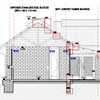

Patongo Training Centre – information re Brick Making – 6 Feb 2012

photo © Article 25
Uganda Architecture
Location: Patongo, Uganda, Africa
For more information about Article 25 please contact Article 25 at [email protected] or browse the website, www.article-25.org.
African Vocational Training Centre Building Photos © Article 25
African Architecture
Monthly Reports by Article 25
Democratic Republic of Congo Schools
Uganda Architecture
Contemporary Africa Architectural Designs – recent selection from e-architect:
National Teachers Colleges, near the towns of Kaliro and Mubende, Uganda
Design: Oubuntu-DASUDA & BKVV Architects
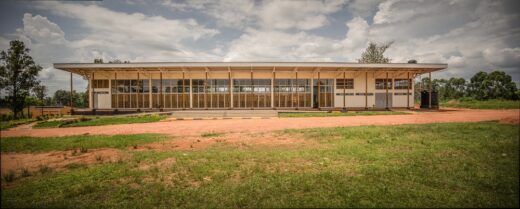
Eppo Karsijn
photos : Eppo Karsijns and Nambasa Sabrina – Frame Media
National Teachers Colleges, Mubende Uganda
Bidi Bidi Refugee Music & Arts Centre, Uganda
Design: Hassell with LocalWorks
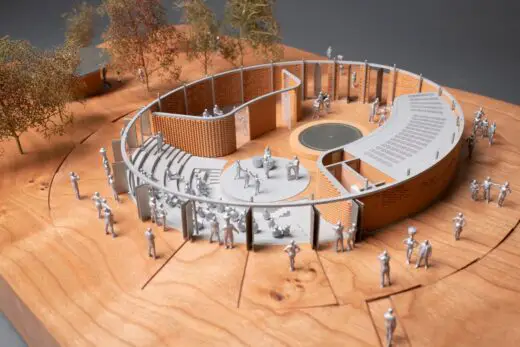
image courtesy of architects office
Bidi Bidi Pavilion at London Design Biennale
Kampala Tower
Design: Capita Symonds
Kampala Tower Development
British High Commission Kampala
Design: Kilburn Nightingale Architects
British High Commission Kampala
Ashinaga Uganda Dormitory in Nansana, Uganda
African Architectural Designs
CAfrica Architecture Designs – recent selection from e-architect:
Pure Power/Daily Combat Strategy for Water Collection, Rujewa, Tanzania, eastern Africa
Design: Hong-En,Lin
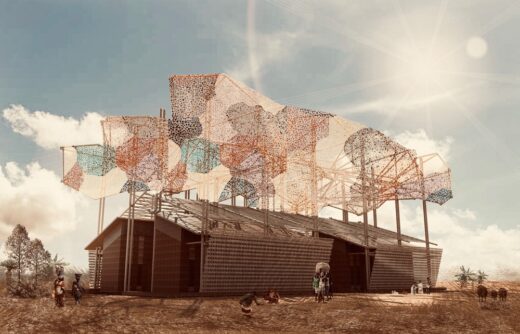
render : Hong-En,Lin
Pure Power, Tanzania, Eastern Africa
Comments / photos for the Uganda Buildings by Article 25 – African Vocational Training Centre Architecture page welcome.

